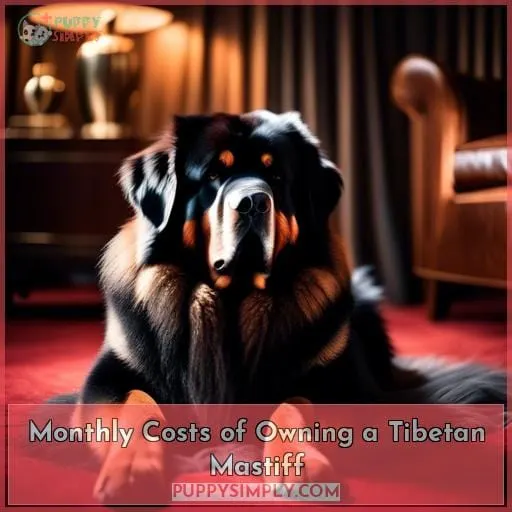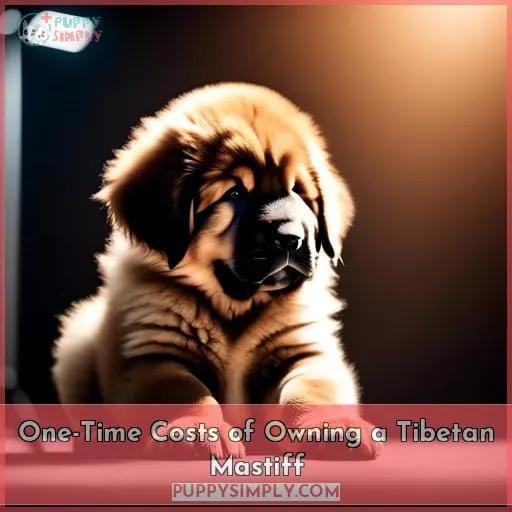This site is supported by our readers. We may earn a commission, at no cost to you, if you purchase through links.
 Like a diamond in the rough, the Tibetan Mastiff’s price is a fascinating topic that can reveal a wealth of knowledge about this enigmatic breed.
Like a diamond in the rough, the Tibetan Mastiff’s price is a fascinating topic that can reveal a wealth of knowledge about this enigmatic breed.
From the factors that influence its value to the ongoing costs of ownership, this comprehensive guide will unveil the secrets behind the Tibetan Mastiff’s price tag, empowering you to make informed decisions about bringing one of these majestic creatures into your life.
Factors Influencing the Tibetan Mastiff’s Price:
- Lineage and Bloodline: The lineage and bloodline of a Tibetan Mastiff play a significant role in determining its price. Puppies from reputable breeders with a history of producing high-quality dogs tend to command higher prices.
- Health and Temperament: The health and temperament of a Tibetan Mastiff are also crucial factors that influence its price. Puppies that have undergone thorough health screenings and exhibit a stable and friendly temperament are generally more expensive.
- Show Quality: Tibetan Mastiffs bred specifically for show purposes may carry a higher price tag due to their exceptional conformation and adherence to breed standards.
- Rarity and Demand: The rarity and demand for Tibetan Mastiffs in a particular region can also impact their price. In areas where the breed is less common, prices may be higher due to limited availability.
Ongoing Costs of Tibetan Mastiff Ownership:
- Food and Nutrition: Tibetan Mastiffs are large dogs with hearty appetites. Providing them with a high-quality diet can be a significant ongoing expense.
- Veterinary Care: Regular veterinary checkups, vaccinations, and potential health issues can add up over time. Pet insurance can help mitigate these costs.
- Grooming: Tibetan Mastiffs require regular grooming to maintain their thick coats. Professional grooming services can be expensive, but DIY grooming can save money.
- Training and Socialization: Training and socialization are essential for Tibetan Mastiffs to become well-behaved companions. Professional training classes can be costly, but DIY training with patience and consistency can be effective.
- Exercise and Enrichment: Tibetan Mastiffs need plenty of exercise and mental stimulation to stay happy and healthy. Providing them with toys, interactive games, and outdoor activities can be an ongoing expense.
By understanding the factors that influence the Tibetan Mastiff’s price and the ongoing costs of ownership, you can make an informed decision about whether this breed is the right fit for your lifestyle and budget.
Table Of Contents
- Key Takeaways
- Tibetan Mastiff Price
- Factors Affecting Tibetan Mastiff Price
- Monthly Costs of Owning a Tibetan Mastiff
- One-Time Costs of Owning a Tibetan Mastiff
- Lifetime Cost of Owning a Tibetan Mastiff
- Frequently Asked Questions (FAQs)
- What are the key distinguishing features of the Tibetan Mastiff that set it apart from other dog breeds?
- Are there any notable historical events or cultural associations related to the Tibetan Mastiff that have influenced its popularity or significance?
- How does the Tibetan Mastiff’s temperament and behavior compare to other large dog breeds, such as the Great Dane or the Saint Bernard?
- What are some of the unique challenges or considerations associated with training and socializing a Tibetan Mastiff, given its independent and protective nature?
- Are there any specific health conditions or genetic predispositions that potential Tibetan Mastiff owners should be aware of before bringing one into their home?
- Conclusion
Key Takeaways
- Tibetan Mastiff prices range from $2,000 to $6,000, influenced by factors like coat color, age, gender, and breeder reputation.
- Ongoing costs include food, veterinary care, grooming, training, socialization, exercise, and enrichment, totaling $380–$670 per month.
- One-time costs include adoption or breeder fees, initial setup costs, microchipping, vaccines, and miscellaneous supplies, totaling $960–$1,280.
- Pet insurance or a savings account is recommended for unexpected medical expenses.
Tibetan Mastiff Price
Brace yourself for the staggering cost of owning a Tibetan Mastiff, a breed that’ll set you back a pretty penny.
Their price tag can leave you reeling, with an average puppy costing between $2000 and $6000.
Factors like coat color, age, gender, and breeder reputation can send the price soaring even higher.
And that’s before you factor in the ongoing expenses of food, grooming, and veterinary care.
But for those willing to pay the price, a Tibetan Mastiff can be a loyal and loving companion for years to come.
Factors Affecting Tibetan Mastiff Price
When considering the price of a Tibetan Mastiff, you’ll find that factors like coat color, age, gender, and breeder reputation can significantly impact the final cost.
For instance, a rare red Tibetan Mastiff can fetch a higher price than a more common black one.
Coat Color
Considering Tibetan Mastiffs’ coat color is a must when gauging their price.
Rarity plays a pivotal role, with golden-haired and red-haired Mastiffs commanding higher sums.
Their unique markings and diverse coat patterns further influence value.
Color is a canvas of exclusivity, a testament to a lineage steeped in history and grandeur.
Age
You’ll often find that older Tibetan Mastiffs are priced lower than puppies.
This is because they may have:
- Aging concerns
- Health considerations
- Training challenges
However, adopting an older mastiff can be incredibly rewarding, as they often come with years of:
- Historical significance
- Cultural relevance
Consider the costs associated with:
- Preventive care coverage
- Licensed specialist visits
- Spaying and neutering
before making your decision.
Gender
When it comes to pricing, you’ll find a slight difference depending on whether you’re getting a male or female Tibetan Mastiff.
Males tend to be larger and more muscular, commanding a higher price.
Females are often preferred for their gentler temperament and trainability.
| Characteristic | Male | Female |
|---|---|---|
| Size | Larger, more muscular | Smaller, more compact |
| Temperament | More dominant, protective | Gentler, more trainable |
| Price | Higher | Lower |
Ultimately, the best gender for you depends on your lifestyle and preferences.
Consider these factors carefully before making a decision.
Breeder Reputation
Breeder’s reputation matters when determining a Tibetan Mastiff’s price.
Seek breeders dedicated to preserving the breed’s integrity, adhering to ethical breeding practices, and prioritizing the dogs’ well-being.
Reputable breeders often command higher prices due to their commitment to quality and adherence to breed standards, ensuring you receive a healthy, well-bred Tibetan Mastiff.
Conversely, unethical breeders or puppy mills may sell dogs at lower prices, but these dogs may come with health and temperament issues, leading to costly future expenses.
Monthly Costs of Owning a Tibetan Mastiff
When budgeting for a Tibetan Mastiff, you’ll need to factor in monthly costs for:
- Diet: A nutritious diet is essential for maintaining their health.
- Grooming: Regular grooming keeps their thick coat clean and healthy.
- Medical care: Tibetan Mastiffs may require medical attention for common health issues.
Pet insurance or a savings account is recommended to cover unexpected expenses.
Diet
With a Tibetan Mastiff’s large size comes a big appetite, so you’ll need to factor in the cost of high-quality dog food.
Consider your pet’s nutritional needs, choosing brands that prioritize real meat and essential vitamins.
While dietary expenses may seem high, remember that quality food promotes a healthier, happier companion.
Grooming
Monthly grooming costs for your Tibetan Mastiff will typically range from $30 to $40.
This includes regular brushing sessions to remove loose hair and prevent matting. Use a firm brush designed for thick coats, brushing in the direction of hair growth.
Bathe your mastiff every 6-8 weeks using a gentle, hypoallergenic shampoo. Trim their nails regularly to prevent cracking and splitting.
Seasonal shedding requires more frequent brushing to manage loose hair.
A well-groomed Tibetan Mastiff isn’t only aesthetically pleasing but also healthier and happier.
Medical Costs
Medical costs for your Tibetan Mastiff can range from $150 to $300 each month.
Safeguard your canine companion’s well-being with preventive care, including annual wellness tests and vaccinations.
Be prepared for potential health challenges like hip dysplasia and hypothyroidism, which may require costly treatments.
Consider pet insurance to help offset veterinary expenses.
One-Time Costs of Owning a Tibetan Mastiff
Before bringing a Tibetan Mastiff into your home, you’ll need to consider the initial one-time costs.
These costs typically range from $600 to $800 and are essential for ensuring your Tibetan Mastiff’s well-being and providing them with a safe and comfortable environment.
These initial costs include:
- Microchipping
- Vaccines
- Miscellaneous supplies
Initial Costs
You’ll need to shell out anywhere from $500 to $600 to get started with your Tibetan Mastiff.
This includes:
- Adoption or breeder fees
- Initial setup costs like a crate, bed, leash, and food and water bowls
These starter investments are essential to provide your new furry friend with a comfortable and secure home.
Microchipping
The microchipping cost for your Tibetan Mastiff will likely fall between $60 and $80, a small price to pay for the peace of mind that comes with knowing your beloved companion can be identified if they ever get lost.
This tiny chip, implanted between your dog’s shoulder blades, holds a unique identification number that can be scanned by veterinarians and animal shelters, increasing the chances of a joyful reunion should they wander off.
Microchipping isn’t only a responsible choice for pet owners, it may also be a legal requirement in some areas, so check local regulations to ensure compliance.
Vaccines
To vaccinate your Tibetan Mastiff against common diseases, you’ll spend between $200 and $250.
This investment ensures your furry companion’s well-being by protecting them from potentially life-threatening illnesses.
Vaccination schedules vary by region and breed, so consulting your veterinarian for personalized recommendations is vital.
Miscellaneous
Moving onto miscellaneous costs:
- Dog license: $15-$20
- Crate: $50-$100
- Bedding: $20-$50
- Toys: $10-$30
- Grooming tools: $20-$40
These items can add up quickly, so it’s essential to factor them into your budget.
Lifetime Cost of Owning a Tibetan Mastiff
Now, let’s delve into the lifetime cost of owning a Tibetan Mastiff, a figure that demands careful consideration.
Longevity planning is essential, as these gentle giants grace our lives for an average of 12 to 15 years. Prepare financially for the journey, ensuring you can provide the best care for your loyal companion throughout their lifetime.
Healthcare budgeting is paramount, encompassing regular check-ups, vaccinations, and potential treatments for breed-specific health conditions. Remember, adopting a Tibetan Mastiff is a commitment that goes beyond the initial cost.
Economic forecasting and investment strategy come into play as you plan for the future. Consider setting aside funds specifically for your furry friend’s care, ensuring financial stability in meeting their needs.
Involve your children in this budgeting process, teaching them responsibility and the value of caring for animals. Tibetan Mastiffs, with their inherent protective nature, may instinctively guard your children, creating an unbreakable bond.
Think beyond the financial implications; owning a Tibetan Mastiff is an experience that transcends monetary value. Their unwavering loyalty, unwavering companionship, and unwavering devotion make them priceless additions to any family.
Like the ancient Buddhist monasteries that have stood the test of time, these majestic creatures embody strength, resilience, and unwavering devotion. They’re not just dogs; they’re family members, companions in life’s adventures, and guardians of your heart.
Frequently Asked Questions (FAQs)
What are the key distinguishing features of the Tibetan Mastiff that set it apart from other dog breeds?
With its imposing size,
majestic double coat,
and unwavering loyalty,
the Tibetan Mastiff stands apart,
embodying strength,
independence,
and unwavering devotion.
Its protective nature
and keen intelligence
make it a guardian like no other.
Are there any notable historical events or cultural associations related to the Tibetan Mastiff that have influenced its popularity or significance?
Journey through history to uncover the Tibetan Mastiff’s profound cultural significance.
From ancient Tibetan monasteries to modern-day status symbol, discover the tales of loyalty, protection, and unwavering companionship that have shaped its legacy.
How does the Tibetan Mastiff’s temperament and behavior compare to other large dog breeds, such as the Great Dane or the Saint Bernard?
How does the Tibetan Mastiff, revered for its loyalty and strength, compare to other gentle giants?
Its calm demeanor and patient nature make it a gentle protector.
While its independent spirit demands a leader.
What are some of the unique challenges or considerations associated with training and socializing a Tibetan Mastiff, given its independent and protective nature?
Training a Tibetan Mastiff demands patience, consistency, and understanding its independent nature.
Socialize early to manage its protective instincts, using positive reinforcement.
Seek professional help if needed.
Are there any specific health conditions or genetic predispositions that potential Tibetan Mastiff owners should be aware of before bringing one into their home?
Before welcoming a Tibetan Mastiff into your home, be aware of potential health concerns:
- Hip dysplasia
- Elbow dysplasia
- Hypothyroidism
- Heart problems
Regular check-ups are crucial for their well-being.
Conclusion
Take Elsa, a majestic Tibetan Mastiff. Her lineage and exceptional temperament made her a valuable addition to her breeder’s line.
But her owners understood that the Tibetan Mastiff’s price is just the beginning. Ongoing costs like premium food, regular grooming, and potential health issues require careful budgeting.
With love, commitment, and financial planning, you can provide a Tibetan Mastiff with a fulfilling life, making the investment in this extraordinary breed worthwhile.










